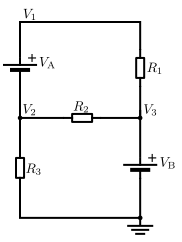Nodal analysis

In electric circuits analysis, nodal analysis, node-voltage analysis, or the branch current method is a method of determining the voltage (potential difference) between "nodes" (points where elements or branches connect) in an electrical circuit in terms of the branch currents.
In analyzing a circuit using Kirchhoff's circuit laws, one can either do nodal analysis using Kirchhoff's current law (KCL) or mesh analysis using Kirchhoff's voltage law (KVL). Nodal analysis writes an equation at each electrical node, requiring that the branch currents incident at a node must sum to zero. The branch currents are written in terms of the circuit node voltages. As a consequence, each branch constitutive relation must give current as a function of voltage; an admittance representation. For instance, for a resistor, Ibranch = Vbranch * G, where G (=1/R) is the admittance (conductance) of the resistor.
Nodal analysis is possible when all the circuit elements' branch constitutive relations have an admittance representation. Nodal analysis produces a compact set of equations for the network, which can be solved by hand if small, or can be quickly solved using linear algebra by computer. Because of the compact system of equations, many circuit simulation programs (e.g. SPICE) use nodal analysis as a basis. When elements do not have admittance representations, a more general extension of nodal analysis, modified nodal analysis, can be used.
Method
- Note all connected wire segments in the circuit. These are the nodes of nodal analysis.
- Select one node as the ground reference. The choice does not affect the result and is just a matter of convention. Choosing the node with the most connections can simplify the analysis. For a circuit of N nodes the number of nodal equations is N−1.
- Assign a variable for each node whose voltage is unknown. If the voltage is already known, it is not necessary to assign a variable.
- For each unknown voltage, form an equation based on Kirchhoff's current law. Basically, add together all currents leaving from the node and mark the sum equal to zero. Finding the current between two nodes is nothing more than "the node you're on, minus the node you're going to, divided by the resistance between the two nodes."
- If there are voltage sources between two unknown voltages, join the two nodes as a supernode. The currents of the two nodes are combined in a single equation, and a new equation for the voltages is formed.
- Solve the system of simultaneous equations for each unknown voltage.
Examples
Basic case

The only unknown voltage in this circuit is V1. There are three connections to this node and consequently three currents to consider. The direction of the currents in calculations is chosen to be away from the node.
- Current through resistor R1: (V1 - VS) / R1
- Current through resistor R2: V1 / R2
- Current through current source IS: -IS
With Kirchhoff's current law, we get:

This equation can be solved with respect to V1:

Finally, the unknown voltage can be solved by substituting numerical values for the symbols. Any unknown currents are easy to calculate after all the voltages in the circuit are known.

Supernodes

In this circuit, we initially have two unknown voltages, V1 and V2. The voltage at V3 is already known to be VB because the other terminal of the voltage source is at ground potential.
The current going through voltage source VA cannot be directly calculated. Therefore we cannot write the current equations for either V1 or V2. However, we know that the same current leaving node V2 must enter node V1. Even though the nodes cannot be individually solved, we know that the combined current of these two nodes is zero. This combining of the two nodes is called the supernode technique, and it requires one additional equation: V1 = V2 + VA.
The complete set of equations for this circuit is:

By substituting V1 to the first equation and solving in respect to V2, we get:

See also
References
- P. Dimo Nodal Analysis of Power Systems Abacus Press Kent 1975
External links
| Wikiversity has learning materials about Nodal analysis |